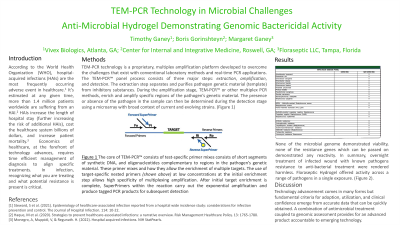Laboratory Research
(LR-007) TEM-PCR Technology in Microbial Challenges; Anti-Microbial Hydrogel Demonstrating Genomic Bacteriocidal Activity

Boris Gorinshteyn, DNP; Margaret Ganey, Allied Health – Director of Operations, Floraseptic, LLC
Introduction: According to the World Health Organization (WHO), hospital-acquired infections (HAIs) are the most frequently occurring adverse event in healthcare.1 It’s estimated at any given time, more than 1.4 million patients worldwide are suffering from an HAI.2 HAIs increase the length of hospital stay (further increasing the risk of additional HAIs), cost the healthcare system billions of dollars, and increase patient mortality.3 Economics of healthcare, at the forefront of technology advances, requires time efficient management of diagnosis to align specific treatments. In infection, recognizing what you are treating and what potential resistance is present is critical.
TEM-PCR technology is a proprietary, multiplex amplification platform developed to overcome the challenges that exist with conventional laboratory methods and real-time PCR applications. The TEM-PCR™ panel process consists of three major steps: extraction, amplification, and detection. The extraction step separates and purifies pathogen genetic material (template) from inhibitory substances. During the amplification stage, TEM-PCR™ or other multiplex PCR methods, enrich and amplify specific regions of the pathogen’s genetic material. The presence or absence of the pathogen in the sample can then be determined during the detection stage using a microarray with broad context of current and evolving strains.
Methods: Isolated strains of identified strains of MRSA, Pseudomonas, Klebsiella, and Beta-Strep that demonstrated resistance were inoculated onto appropriate culture media, treated with Floraseptic hydrogel, incubated overnight, and samples were sent to Eurofins (Huntsville, AL) for TEM-PCR assessment. Under CLIA approval, results were returned within 8 hours for all microbes assessed.
Results: None of the microbial genome demonstrated viability, none of the resistance genes which can be passed on demonstrated any reactivity. In summary, overnight treatment of infected wound with known pathogens resistance to anti-bacterial treatment were rendered harmless. Floraseptic Hydrogel offered broad activity across a range of pathogens in a single exposure.
Discussion: Technology advancement comes in many forms but fundamental criteria for adoption, utilization, and clinical confidence emerge from accurate data that can be quickly obtained. A combination of antimicrobial treatment coupled to genomic assessment provides for an advanced product accountable to emerging technology.
Trademarked Items: Floraseptic
References: [1] Steward, S et al. (2021). Epidemiology of healthcare-associated infection reported from a hospital wide incidence study: considerations for infection prevention and control. The Journal of Hospital Infection. 114: 10-22.
[2] Haque, M et al. (2020). Strategies to prevent healthcare-associated infections: a narrative overview. Risk Management Healthcare Policy. 13: 1765-1780.
[3] Monegro, A, Muppidi, V, & Regunath. H. (2022). Hospital acquired infections. NIH StatPearls.
TEM-PCR technology is a proprietary, multiplex amplification platform developed to overcome the challenges that exist with conventional laboratory methods and real-time PCR applications. The TEM-PCR™ panel process consists of three major steps: extraction, amplification, and detection. The extraction step separates and purifies pathogen genetic material (template) from inhibitory substances. During the amplification stage, TEM-PCR™ or other multiplex PCR methods, enrich and amplify specific regions of the pathogen’s genetic material. The presence or absence of the pathogen in the sample can then be determined during the detection stage using a microarray with broad context of current and evolving strains.
Methods: Isolated strains of identified strains of MRSA, Pseudomonas, Klebsiella, and Beta-Strep that demonstrated resistance were inoculated onto appropriate culture media, treated with Floraseptic hydrogel, incubated overnight, and samples were sent to Eurofins (Huntsville, AL) for TEM-PCR assessment. Under CLIA approval, results were returned within 8 hours for all microbes assessed.
Results: None of the microbial genome demonstrated viability, none of the resistance genes which can be passed on demonstrated any reactivity. In summary, overnight treatment of infected wound with known pathogens resistance to anti-bacterial treatment were rendered harmless. Floraseptic Hydrogel offered broad activity across a range of pathogens in a single exposure.
Discussion: Technology advancement comes in many forms but fundamental criteria for adoption, utilization, and clinical confidence emerge from accurate data that can be quickly obtained. A combination of antimicrobial treatment coupled to genomic assessment provides for an advanced product accountable to emerging technology.
Trademarked Items: Floraseptic
References: [1] Steward, S et al. (2021). Epidemiology of healthcare-associated infection reported from a hospital wide incidence study: considerations for infection prevention and control. The Journal of Hospital Infection. 114: 10-22.
[2] Haque, M et al. (2020). Strategies to prevent healthcare-associated infections: a narrative overview. Risk Management Healthcare Policy. 13: 1765-1780.
[3] Monegro, A, Muppidi, V, & Regunath. H. (2022). Hospital acquired infections. NIH StatPearls.

.png)
